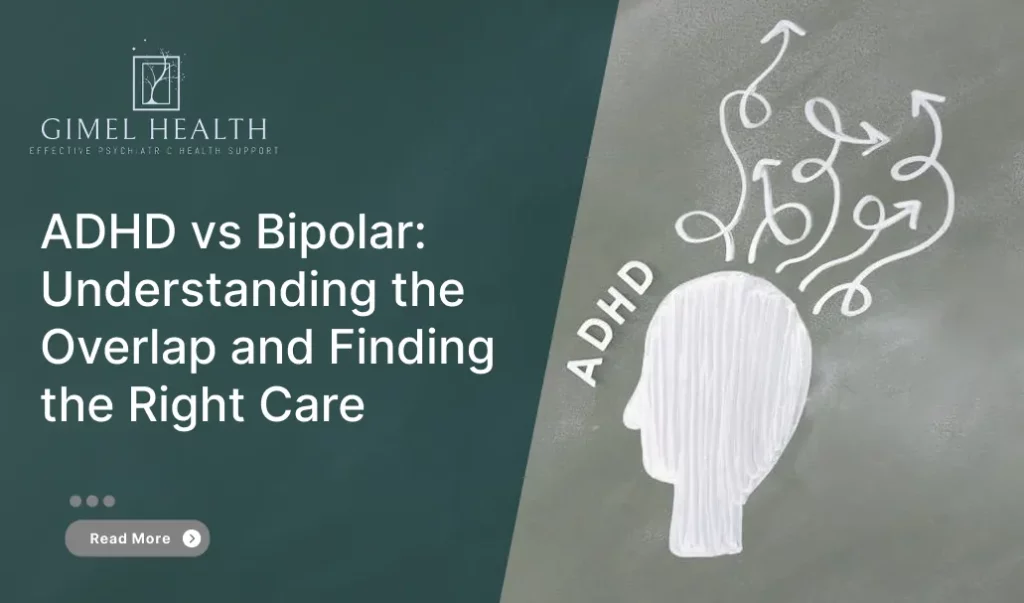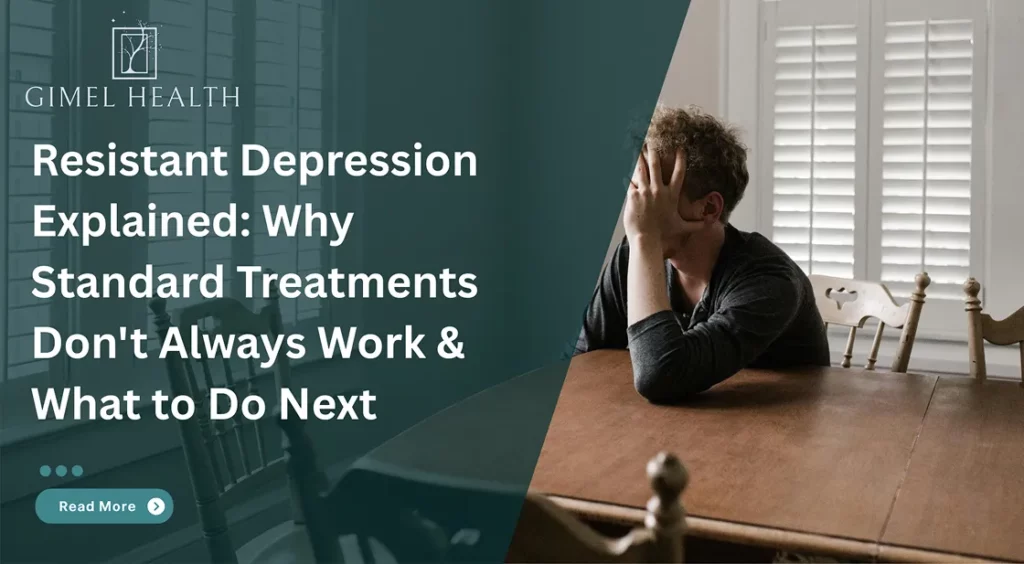
5 Signs You May Need Professional Psychiatric Medication Management
Medication can be life-changing when it’s prescribed and monitored correctly; but when doses, timing, or side effects become confusing, it

Mania is a serious mental health condition often associated with bipolar I disorder, schizoaffective disorder, or other mood disorders. It is marked by high energy levels, impulsive behaviors, manic depression, and elevated or irritable mood that can interfere with decision-making and daily life. Recognizing the early signs and symptoms of mania, such as rapid speech, reduced need for sleep, grandiose thinking, and risky behavior, is crucial for early intervention.
A manic phase typically lasts at least one week and can severely impact personal relationships, job performance, and physical health. In some cases, manic patients may also experience psychotic symptoms, such as delusions or hallucinations, which require immediate medical attention.
Mania can develop due to a combination of biological, genetic, and environmental factors, as well as drug use. A family history of mood disorders and mental illness increases the likelihood of developing manic symptoms. Substance abuse, including recreational drugs or alcohol, can also trigger or worsen episodes of mania.
Underlying medical conditions, such as thyroid disorders or neurological issues, may play a role. In some cases, certain medications or sleep deprivation can also lead to manic states. Understanding the root cause is key to developing an effective treatment plan for long-term stability and mental wellness.
![2[1] 2[1]](https://gimelhealth.com/wp-content/uploads/elementor/thumbs/21-1-r71sk1o6ku76le06eo06bgtiyc495l9pc1blfqttug.png)
The diagnostic criteria of mania typically follow the criteria outlined in the Diagnostic and Statistical Manual of Mental Disorders by the American Psychiatric Association. Healthcare providers do a systematic review and assess patterns of mood episodes, energy levels, and psychotic features. To rule out other medical conditions, providers may conduct lab tests, psychological evaluations, and a full clinical history.
The diagnosis is essential for identifying the presence of bipolar I disorder, bipolar II disorder, or other related mood disorders. Identifying whether the individual is experiencing a full manic episode or hypomanic episodes is critical to determining the best course of treatment.
Effective treatment for mania usually combines medication, therapy, and lifestyle changes. Mood stabilizers, such as lithium carbonate and valproic acid, are considered first-line treatment options. These medications help regulate mood swings and reduce the intensity and duration of manic episodes. Antipsychotic medications, including second-generation or atypical antipsychotics, are often prescribed if psychotic symptoms are present.
When considering Treatment For Mania, hospitalization may be required for acute or severe manic episodes. In treatment-resistant cases, electroconvulsive therapy is a safe and proven intervention used to reduce manic symptoms rapidly.
Psychotherapy, particularly cognitive behavioral therapy and family-focused therapy, can help individuals recognize triggers, manage stress, and reduce the risk of rapid cycling or depressive episodes. A combination therapy approach often yields the best long-term outcomes.
Managing mania is a long-term process. Once the acute manic state has stabilized, maintenance treatment becomes essential. This includes ongoing medication management, lifestyle adjustments, and regular check-ins with a mental health professional. Social rhythm therapy, which focuses on maintaining stable routines, can prevent future mood episodes.
Support groups offer additional help, allowing individuals to connect with others who understand their experiences. Involving family members in the recovery process improves communication and reduces the risk of future episodes.
By recognizing manic symptoms early, seeking medical advice, and committing to a tailored treatment plan, individuals can lead productive and fulfilling lives despite challenges related to mood disorders.

Bipolar disorder is a complex mental illness that involves alternating mood episodes of mania, depression, or both. During acute bipolar mania, individuals may exhibit extreme energy, rapid speech, psychotic symptoms, and an inability to manage daily responsibilities. These symptoms can resemble other psychotic disorders, which is why an accurate diagnosis is essential for early intervention.
Bipolar disorder treatment begins with stabilizing the acute phase. Acute treatment often involves mood stabilizers and antipsychotic medications to control the manic state quickly and safely. Patients with a history of severe manic or psychotic episodes are at high risk for complications if left untreated.
The treatment of bipolar disorder doesn’t end with acute care. Long-term success depends on structured follow-up, medication management, and therapy to maintain stability and prevent relapse. Proper care reduces the risk of future episodes and improves overall quality of life.
Living with the symptoms of bipolar disorder can be overwhelming, but you don’t have to face it alone. If you or a loved one is struggling with mania or a suspected related mental illness, now is the time to seek professional mental health care. An experienced healthcare provider can offer a diagnosis and help you develop a personalized treatment plan.
Ongoing care, therapy, and support groups can make a significant difference in managing your mental health. Whether you are dealing with manic symptoms, depressive episodes, or a combination of both, effective help is available. Reach out today to take the first step toward long-term healing and a more balanced life.

Medication can be life-changing when it’s prescribed and monitored correctly; but when doses, timing, or side effects become confusing, it

Distinguishing ADHD vs Bipolar disorder can be confusing. Both involve intense emotions, bursts of energy, and difficulty with focus or

Understanding the Struggle With Depression Here’s something most people don’t realize about depression: it’s not a one-size-fits-all condition. I’ve worked
Your journey to better mental health starts here. With advanced expertise in biology and psychiatry, I build exclusive medication plans backed by science. Contact me to schedule your initial consultation.
(201) 815-4351
440 West Str, Ste 307, Fort Lee Bergen County NJ 07024
Early signs of mania often begin subtly and can include mood swings, high energy levels, decreased need for sleep, and impulsive behaviors. Individuals may also experience racing thoughts, pressured speech, or an inflated sense of self-confidence. These manic symptoms, if left untreated, can escalate into a full-blown manic episode, potentially disrupting daily life and relationships. Early intervention from a healthcare provider can significantly reduce the severity and impact of these episodes.
Bipolar II disorder is characterized by recurring hypomanic episodes and depressive episodes, while bipolar I includes at least one manic episode, often with psychotic features. Although hypomania is less intense than mania, it can still lead to risky behavior and impact judgment. In clinical practice, bipolar II is sometimes misdiagnosed due to the absence of severe mania, delaying proper treatment. Accurate diagnosis of bipolar disorder is essential for developing an appropriate treatment plan and preventing long-term cognitive impairment.
Mood stabilizers such as lithium carbonate, valproic acid, and divalproex sodium are crucial in the treatment for mania. They help balance brain chemistry, reduce mood swings, and prevent both manic and depressive episodes. While effective, these medications can carry adverse effects like weight gain, cognitive slowing, or gastrointestinal issues. Your mental health professional will tailor the medication regimen to suit your specific needs, monitor for side effects, and adjust the dosage as part of ongoing maintenance treatment.
Electroconvulsive therapy (ECT) is often used for individuals experiencing severe manic episodes, especially those with treatment-resistant mania or psychotic symptoms. ECT is a safe and effective treatment that has been widely studied, including in publications such as Am J Psychiatry and Arch Gen Psychiatry. It may also be recommended for patients who cannot tolerate medications due to other medical conditions or who experience suicidal thoughts during a manic-depressive illness cycle.
Rapid cycling is when a person experiences four or more mood episodes, mania, hypomania, or depression, within a year. It can be triggered by substance use disorders, ineffective medication management, or underlying physical health issues. Mixed mania and irregular sleep patterns may also contribute. Treatment options for rapid cycling often involve combination therapy with mood stabilizers and second-generation antipsychotics, alongside structured therapy like social rhythm therapy to regulate behavioral patterns.
Yes, weight gain is a common adverse effect associated with certain antipsychotic medications and mood stabilizers. This can impact physical health and medication adherence over the long term. Strategies to manage weight gain include lifestyle changes, switching to medications with a lower metabolic risk, and nutritional counseling. Maintaining a healthy daily life routine, including regular meals, sleep, and exercise, is important for minimizing side effects and improving treatment outcomes.
Cognitive behavioral therapy (CBT) helps individuals recognize and change thought patterns that lead to emotional distress or impulsive behaviors. CBT is especially useful in addressing depressive symptoms and decision-making issues during mood episodes. Family-focused therapy involves family members in treatment to enhance communication, reduce conflict, and create a supportive home environment. Both therapies are proven methods in the clinical management of manic-depressive illness and are often used alongside medication as part of combination treatment.
Yes. Substance use disorders, including drug abuse and alcohol misuse, are common among individuals with mood disorders. These substances can worsen manic symptoms or trigger new episodes. Substance use also interferes with medication effectiveness and complicates the diagnosis of bipolar disorder. Treatment should address both the mental health condition and the substance use to reduce relapse risk and improve overall outcomes.
Mixed mania involves the presence of both manic and depressive symptoms at the same time. Someone in a mixed state might experience high energy and agitation along with hopelessness, sadness, or even suicidal ideation. These symptoms of bipolar disorder are particularly dangerous because they increase the risk of self-harm. Treatment for mixed episodes typically involves a careful balance of mood stabilisers and atypical antipsychotics under the supervision of a healthcare professional.
Yes, your primary care provider can often recognize early warning signs such as mood swings, impulsive behaviors, or symptoms of depression. While they may not offer specialized psychiatric care, they can perform initial evaluations and refer you to a mental health provider for comprehensive treatment if you’re experiencing an episode of mania.
Yes. While seasonal affective disorder (SAD) is often linked to winter depression, individuals with bipolar disorder may experience seasonal episodes of mania in spring or summer. Tracking seasonal patterns is important in long-term treatment planning, especially when depressive or manic episodes follow predictable cycles.